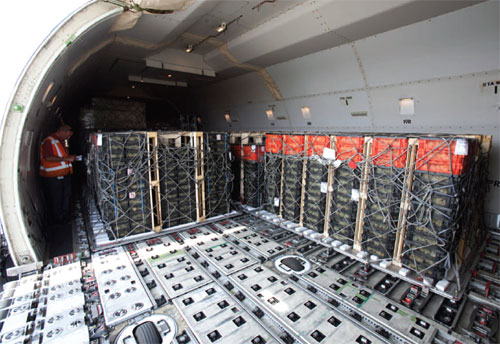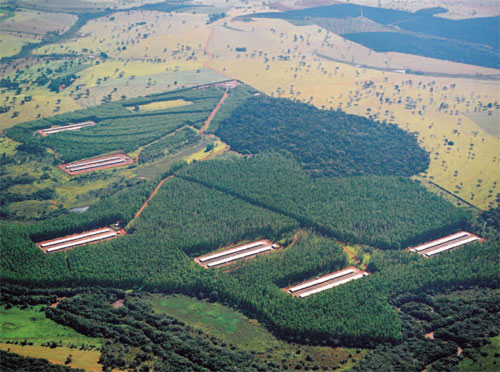



Compartmentalisation Progress Still Hinges on Trading Partner Acceptance
The future of global trade during times of disease outbreaks depends on the success of 'compartments', which have government approval and are recognised by trading partners. Encouraging progress is being made in the UK, USA and Brazil, according to an article in the latest issue of Cobb Focus.A global consensus on compartmentalisation might be some way off – but there are encouraging moves in countries across the world that this goal is achievable.
The UK was the first to launch its own government backed scheme in October, 2009. In the QUAD group of countries – the US, Canada, Australia and New Zealand – and in Brazil, moves are progressing towards establishing programmes that will meet the approval of trading partners.
United Kingdom: Key to scheme ‘no admin burden or cost to government’
Poultry breeding companies in the UK have been working for more than two years to set up the Government-backed compartmentalisation scheme, which was launched in October 2009.
Through the British Poultry Council (BPC), the breeding companies have worked with the Department for the Environment, Food and Rural Affairs (Defra) to develop the management protocols, biosecurity systems and husbandry practices on which the scheme is based.
The Veterinary Laboratories Agency (VLA) has a key role in the scheme, responsible for inspecting and approving farm, hatchery and other premises for compartment status.
 |
“We provided the government with a finished package which they accepted,” says Mr Kyle. “Third Countries are only interested in official schemes and it is essential for the government to take ownership of the package so that it is accepted internationally. “Equally, it is important to have a set of inspectors who are recognised as independent and we worked closely with the VLA to ensure their inspectors are fully trained in what is needed to achieve compartment status.”
The UK scheme goes beyond the EU standard in covering Newcastle disease as well as avian influenza.
Companies entering the scheme may have individual premises approved as separate compartments, or have a number of separate but functionally linked premises approved collectively as a single compartment. Initial approval can only be granted when there are no restrictions in place in the country for avian influenza. There is no time limit on an approval although re-inspection is required on a two-year cycle with half of the sites inspected each year.
If a Third Country requires more frequent inspections, the company will decide whether it wants to go to the extra expense of additional inspections to continue trading with that country.
In the event of a disease outbreak, UK and EU disease control regulations take precedence over compartment rules. Where exports are not prohibited under such regulations, consignments to Third Countries willing to accept breeding stock from approved compartments will be accompanied by a certificate confirming the compartment status of the premises of origin. However, trade decisions are entirely at the discretion of authorities in Third Countries and hence the need to gain their confidence in the validity of the scheme.

United States: Transparency needs to be apparent to trading partners
“While compartmentalisation will be different for many of our trading partners around the world, we are working hard on getting a broad, widely accepted protocol for compartmentalisation to serve a significant number of countries,” says Julia Punderson, senior staff veterinarian of the US Department of Agriculture’s Animal and Plant Health Inspection Service (USDA/AHIS).
The emphasis is on creating a transparent scheme that will meet the expectations of OIE, the Paris-based world organisation for animal health. Details of the US industry pilot project were presented to the QUAD group of companies comprising, the US, Canada, Australia and New Zealand at a meeting in December.
“All of us want to work toward a scheme that fits individual governments yet is applicable to our industry trading partners,” says Julia Punderson. “We recognise it may be difficult to implement given it has not been tested but countries taking our exports will better understand the integrity of the programme once the steps, details and transparency are apparent to them.”
Government controls will play a big part in establishing a credible compartment, with audits and appropriate documentation essential to any scheme and having specific objectives and requirements to make them plausible. The bulk of the work will go into establishing and confirming a compartment, with the audit a repeatable procedure.
“It is hoped we can build on the current industry procedures – with the high standards of bio-security, management and documentation already in place – to limit further cost,” says Ms Punderson.
Over and above the animal health baseline currently operating in the US, USDA/APHIS will support the specific requirements needed to create and maintain compartments for the US breeding industry.
The QUAD meeting in February will consider proposals and comments from the group and enable the scheme to progress to APHIS for approval.
OIE standards are seen as the best option for achieving acceptance from a trading partner so that there is bilateral agreement. The USDA will sign the health certificate for compartmentalization, then this can be presented to a trading partner to seek response and approval from that country before publication of a ‘final rule’ in the Federal Register in the US.
“We need partners to understand our system and how we will manage it,” says Ms Punderson. “For instance, how we identify disease and yet avoid shutting down the whole industry so it is able to continue to supply product to customers.”
‘With the current open relationship and the good responses to our questions by industry, the future benefits from compartmentalisation look to be achievable,” she concludes.
Brazil: Aiming for OIE recognition within 12 months

In Brazil, the industry has a National Plan for the Prevention of Avian influenza and for the Control of Newcastle Disease. With the assistance from the prevention plan already in place, the breeding industry has been working for over two years on advancing compartmentalisation.
The industry appointed an independent consultant, Professor Masaio Mizuno Ishizuka, to lead and coordinate data and material required to present to the federal veterinary service MAPA for approval.
Currently biosecurity provision for breeding companies has been approved by MAPA and certificates are issued after successful inspection, periodically each year, to enable trade with other countries.
MAPA is responsible for international trade in agriculture, with a local federal veterinarian signing-off an inspection of a breeding company’s facilities. There is only one official laboratory in Brazil that confirms the health status certification for a breeding company.

The process towards compartmentalisation is divided into three steps:
- Approval by MAPA of breeding company facility biosecurity is in place.
- Approval for a contingency plan to manage a disease outbreak either inside the facility, within an immediate surveillance zone or further out from the breeding facility location is yet to be confirmed. A plan is to be presented by the breeding industry to MAPA and approval is anticipated this year.
- It is anticipated that MAPA will present procedures for the broiler industry in Brazil to the OIE for approval in late 2010 or early 2011.
“Continued close collaboration and progress over the past two years between industry and government in Brazil is a great foundation for future success,” commented Professor Masaio.
The development of closer working relationships in Europe, and North and South America, and greater alignment on the details and responsibilities involved in compartmentalisation, has increased the likelihood of several countries gaining OIE recognition.
This is clear evidence of the progress made by industry and government working together. What is being achieved will surely be tested in the crucial step of gaining approval from individual trading partners in the not too distant future.
Further Reading
| - | You can view our previous article on compartmentalisation by clicking here. |
February 2010








